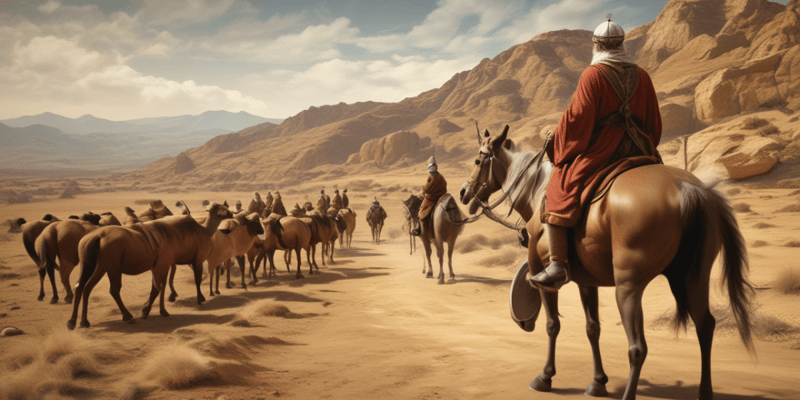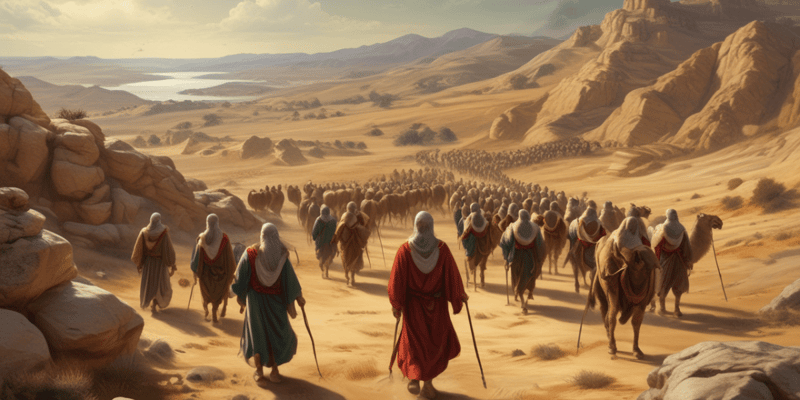10 Questions
The dung gate symbolizes the cleansing of our lives.
True
The fountain gate represents the ministry of the Holy Spirit.
True
The water gate symbolizes the Word of God.
True
The horse gate introduces the idea of love.
False
The east gate makes us think of the second coming of Jesus Christ.
True
The gate Miphkad speaks of God's mercy.
False
The sheep gate symbolizes the judgment of believers.
False
There are only five gates mentioned in the passage.
False
The order of the gates is random and has no significance.
False
The passage teaches that believers will face judgment because of their sins.
False
Study Notes
Introduction to Ezra and Nehemiah
- The books of Ezra and Nehemiah form one book in the Hebrew Bible, telling the story of the return of the remnant to Jerusalem and the rebuilding of the city and the temple.
- The Babylonian Captivity began in 606 B.C. and lasted for 70 years, as predicted by Jeremiah (Jer. 25:12-14; 29:10-14).
- The period of captivity is marked by the deportation of Jews, including Daniel and Ezekiel, and the eventual return of the remnant to Jerusalem.
Chronology of the Period
- 606-605 B.C.: Babylon begins invading and deporting Jews.
- 587 B.C.: Jerusalem falls to the enemy.
- 539 B.C.: Babylon falls to Cyrus and the Media-Persian empire begins.
- 538 B.C.: Cyrus permits the Jews to return to Jerusalem.
- 535 B.C.: The Jews begin to rebuild the temple, but the work stops.
- 520 B.C.: The work begins again, and the temple is completed and dedicated in 515 B.C.
- 476 B.C.: Esther becomes Queen of Persia.
- 458 B.C.: Ezra travels to Jerusalem.
The Leaders
- Ezra:
- A godly and patriotic Jew.
- A priest and a scribe.
- Devoted student of the Scriptures.
- Helped to restore the Law to the nation.
- A man of prayer.
- Led a second group of Jews back to Jerusalem.
- Nehemiah:
- An officer in the king's court.
- A layman with no prophetic call or priestly lineage.
- Promoted to governor.
- Zerubbabel:
- A leader under Ezra.
- Also called Sheshbazzar.
- Official title was "tirshatha", meaning "governor".
- Part of the royal line of David.
- Served as the political leader of the restored nation.
- Joshua:
- The high priest at the time.
- Mentioned in Ezra 3:2, Haggai 1:1, 12, 14, and Zechariah 3:1-10.
The Lessons
- God fulfilled His promise of captivity, but also promised that a remnant would return.
- The captivity cured the Jews of idolatry and gave them a desire to know and obey the Word.
- The Jews forgot their lessons quickly, and the book of Ezra and Nehemiah serves as a reminder of God's faithfulness.
Ezra 1-5
- The return to the land (Ezra 1-2):
- Cyrus's decree to return and rebuild the temple.
- The precious things, including the temple treasures, were restored to the Jews.
- The people, including priests, Levites, and other groups, returned to Jerusalem.
- Rebuilding the temple (Ezra 3):
- Establishing the altar.
- Laying the foundation of the temple.
- The people rejoiced and sang, but older people wept, remembering the former temple.
- Resisting the enemy (Ezra 4):
- The people of the land, including Samaritans, opposed the Jews' work.
- Zerubbabel and Joshua refused their aid.
- The work ceased for 15 years due to opposition.
- Resuming the work (Ezra 5):
- The Word of God was proclaimed by Haggai and Zechariah.
- The work began again, and the temple was completed and dedicated.
Nehemiah 1-3
- Nehemiah prays for the work (Nehemiah 1):
- The report of Jerusalem's state.
- Nehemiah's response, including fasting and praying.
- His request for God's favor and protection.
- Nehemiah prepares for the work (Nehemiah 2):
- Approaching the king.
- The king's favor and provision for the work.
- Nehemiah's investigation of the city's state.
- Nehemiah prospers in the work (Nehemiah 3):
- The pattern of organization and cooperation.
- The people, including spiritual leaders, rulers, and women, worked together.
- The gates of Jerusalem, including the sheep gate, fish gate, old gate, and others, were repaired.
Learn about the return of the remnant to Jerusalem and the rebuilding of the city and the temple after the Babylonian Captivity. Explore the biblical history and prophecies surrounding this period.
Make Your Own Quizzes and Flashcards
Convert your notes into interactive study material.
Get started for free



